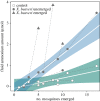Predatory dipteran larva contributes to nutrient sequestration in a carnivorous pitcher plant
- PMID: 29514991
- PMCID: PMC5897610
- DOI: 10.1098/rsbl.2017.0716
Predatory dipteran larva contributes to nutrient sequestration in a carnivorous pitcher plant
Abstract
The fluids of Nepenthes pitcher plants are habitats to many specialized animals known as inquilines, which facilitate the conversion of prey protein into pitcher-absorbable nitrogen forms such as ammonium. Xenoplatyura beaveri (Diptera: Mycetophilidae) is a predatory dipteran inquiline that inhabits the pitchers of Nepenthes ampullaria Larvae of X. beaveri construct sticky webs over the fluid surface of N. ampullaria to ensnare emerging adult dipteran inquilines. However, the interaction between X. beaveri and its host has never been examined before, and it is not known if X. beaveri can contribute to nutrient sequestration in N. ampullaria. Xenoplatyura beaveri individuals were reared in artificial pitchers in the laboratory on a diet of emergent Tripteroides tenax mosquitoes, and the ammonium concentration of the pitcher fluids was measured over time. Fluid ammonium concentration in tubes containing X. beaveri was significantly greater than those of the controls. Furthermore, fluid ammonium concentrations increased greatly after X. beaveri larvae metamorphosed, although the cause of this increase could not be identified. Our results show that a terrestrial, inquiline predator can contribute significantly to nutrient sequestration in the phytotelma it inhabits, and suggest that this interaction has a net mutualistic outcome for both species.
Keywords: Mycetophilidae; Nepenthes ampullaria; Xenoplatyura beaveri; cross-habitat predation; nutritional mutualism; phytotelma.
© 2018 The Author(s).
Conflict of interest statement
We declare we have no competing interests.
Figures


Similar articles
-
Dipteran larvae and microbes facilitate nutrient sequestration in the Nepenthes gracilis pitcher plant host.Biol Lett. 2017 Mar;13(3):20160928. doi: 10.1098/rsbl.2016.0928. Biol Lett. 2017. PMID: 28250210 Free PMC article.
-
Traps of carnivorous pitcher plants as a habitat: composition of the fluid, biodiversity and mutualistic activities.Ann Bot. 2011 Feb;107(2):181-94. doi: 10.1093/aob/mcq238. Epub 2010 Dec 15. Ann Bot. 2011. PMID: 21159782 Free PMC article. Review.
-
A dipteran larva-pitcher plant digestive mutualism is dependent on prey resource digestibility.Oecologia. 2018 Nov;188(3):813-820. doi: 10.1007/s00442-018-4258-4. Epub 2018 Sep 11. Oecologia. 2018. PMID: 30206689
-
Inquiline predator increases nutrient-cycling efficiency of Nepenthes rafflesiana pitchers.Biol Lett. 2019 Dec 24;15(12):20190691. doi: 10.1098/rsbl.2019.0691. Epub 2019 Dec 4. Biol Lett. 2019. PMID: 31795851 Free PMC article.
-
Convergent and divergent evolution in carnivorous pitcher plant traps.New Phytol. 2018 Feb;217(3):1035-1041. doi: 10.1111/nph.14879. Epub 2017 Nov 13. New Phytol. 2018. PMID: 29131340 Review.
Cited by
-
Plant-animal interactions between carnivorous plants, sheet-web spiders, and ground-running spiders as guild predators in a wet meadow community.Ecol Evol. 2020 Mar 30;10(11):4762-4772. doi: 10.1002/ece3.6230. eCollection 2020 Jun. Ecol Evol. 2020. PMID: 32551059 Free PMC article.
-
Digestive mutualism in a pitcher plant supports the monotonic rather than hump-shaped stress-gradient hypothesis model.Oecologia. 2019 Jul;190(3):523-534. doi: 10.1007/s00442-019-04404-1. Epub 2019 May 6. Oecologia. 2019. PMID: 31062163
References
-
- Clarke CM, Kitching RL. 1993. The metazoan food webs from six Bornean Nepenthes species. Ecol. Entomol. 18, 7–16. (10.1111/j.1365-2311.1993.tb01074.x) - DOI
-
- Mogi M, Chan K. 1996. Predatory habits of dipteran larvae inhabiting Nepenthes pitchers. Raffles Bull. Zool. 44, 233–245.
-
- Choo JPS, Koh TL, Ng PKL. 1997. Pitcher fluid macrofauna: nematodes and arthropods. In A guide to the carnivorous plants of Singapore (ed. Tan HTW.), pp. 141–154. Singapore: Singapore Science Centre.
Publication types
MeSH terms
Substances
Associated data
LinkOut - more resources
Full Text Sources
Other Literature Sources

